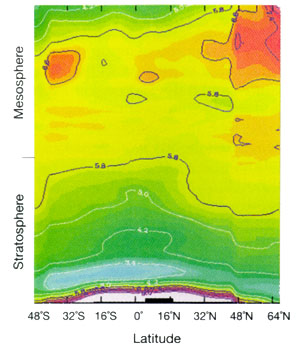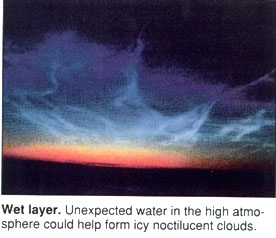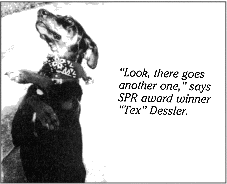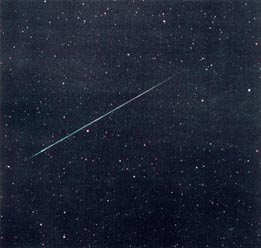|
One of the arguments used against the existence of the small comets was the extreme dryness of our atmosphere above altitudes of 20 to 30 miles. The claim was that, if there was such a large flux of cometary water clouds entering our atmosphere, then surely there must be some evidence of the water vapor at high altitudes. The lack of such water vapor was cast into cartoon form as "falling chickens" in Figure 14 [Not shown. The Ken Brown cartoon spoofs the many impacts of small comets into our atmosphere. Captioned "The effects of rubber chickens on the atmosphere," it shows a scientist recording in a pad the falls of rubber chickens all around him].
However, surprises concerning the amount of water vapor in our high
The photograph and caption of Figure 17 does remind one of the mysteries
of meteors in our atmosphere. An example of a bright meteor trail is
shown in Figure 18 [below]. "Conventional wisdom" of the 1970s
and 1980s stated that the brightest of the meteors in our atmosphere, or
"fireballs", was due to dense rocks impacting our atmosphere,
even though very few were found on the ground at the expected ends of
their trails. One such search effort was the Prairie Network located in
It is quite possible that the loosely bound "dustballs" are in fact small comets. At the peak times for meteor research during 20 to 30 years ago the possibility that these loosely bound objects might be small comets was simply not suggested. After all, the numbers of fireballs with brightnesses similar to or greater than brightest Venus were about 10 million per year, and who would have thought that there were that many small comets impacting Earth's atmosphere. Crude estimates of the brightness of small comets which are devoid of brightly glowing dust particles are indeed about the brightness of Venus, and their impact rate is about 10 million per year. It is remarkable that the orbits and speeds calculated for many of the "fireballs" are similar to those for the small comets. It would be of great interest if we would return to a new investigation of fireballs with cameras which are able to photograph these objects as seen looking down on the atmosphere from a satellite in low Earth orbit. This would provide a wonderful opportunity to determine the contents of the infalling objects without the obscuration by the atmosphere and the very limited view of a ground observer. [Next Page]
|
 atmosphere were revealed with instruments flown on the Space Shuttle and
on the unmanned Upper Atmospheric Research Satellite. These measurements
of unexpected quantities of water vapor at altitudes in our mesosphere in
the range of 40 miles or so are depicted in Figure 15 [right]. Although
most of the cometary water will not be stopped in its rapid downward
motion until it reaches the stratosphere, a small amount of water vapor
is expected to be left at the high altitudes. The findings of such water
vapor, a measurement which is a significant technical achievement,
quieted many of the objections which were based upon the "very dry
upper atmosphere". A further concern now arises if the upper
atmosphere is bathed with a gentle cosmic rain. That concern is the
existence of high-altitude ice clouds at about 55 miles. A photograph of
these clouds which are found at polar latitudes is shown in Figure 16
[below, left]. If the these clouds are due to the presence of cometary
water vapor and their fluxes were to increase, then these clouds could
advance toward lower latitudes. An ice age would ensue.
atmosphere were revealed with instruments flown on the Space Shuttle and
on the unmanned Upper Atmospheric Research Satellite. These measurements
of unexpected quantities of water vapor at altitudes in our mesosphere in
the range of 40 miles or so are depicted in Figure 15 [right]. Although
most of the cometary water will not be stopped in its rapid downward
motion until it reaches the stratosphere, a small amount of water vapor
is expected to be left at the high altitudes. The findings of such water
vapor, a measurement which is a significant technical achievement,
quieted many of the objections which were based upon the "very dry
upper atmosphere". A further concern now arises if the upper
atmosphere is bathed with a gentle cosmic rain. That concern is the
existence of high-altitude ice clouds at about 55 miles. A photograph of
these clouds which are found at polar latitudes is shown in Figure 16
[below, left]. If the these clouds are due to the presence of cometary
water vapor and their fluxes were to increase, then these clouds could
advance toward lower latitudes. An ice age would ensue.
 Even though the small comets were a frequent topic for the press and were
quite popular with the public, several icons of American Geophysical
Union were successful in preventing any article concerning them in the
union's newsletter EOS. This censure continued for over ten years
until the confirmations with the Polar cameras. There was one exception
to this censure which was found to be distasteful to many of the
Even though the small comets were a frequent topic for the press and were
quite popular with the public, several icons of American Geophysical
Union were successful in preventing any article concerning them in the
union's newsletter EOS. This censure continued for over ten years
until the confirmations with the Polar cameras. There was one exception
to this censure which was found to be distasteful to many of the
 society's members. This exception was the dinner award in 1992 to
Alexander Dessler's dog for "keen astronomical observations and
loyalty to authority". The award photograph is shown in Figure
17[right]. But such ridicule is expected in such a hotly contested issue
as small comets. I point out to young scientists in all fields that an
advance to the frontier of knowledge can often lead to difficult
"rites of passage".
society's members. This exception was the dinner award in 1992 to
Alexander Dessler's dog for "keen astronomical observations and
loyalty to authority". The award photograph is shown in Figure
17[right]. But such ridicule is expected in such a hotly contested issue
as small comets. I point out to young scientists in all fields that an
advance to the frontier of knowledge can often lead to difficult
"rites of passage".
 the midwest U.S. which employed simultaneous sightings by several
separated observers and determinations of the point of ground impact by
triangulation. Only a sparse handful of meteoritic rocks were found with
these searches. A debate over the possibility that the fireballs were
due to loosely bound dust rather than the usually accepted iron and stony
rocks was never fully resolved.
the midwest U.S. which employed simultaneous sightings by several
separated observers and determinations of the point of ground impact by
triangulation. Only a sparse handful of meteoritic rocks were found with
these searches. A debate over the possibility that the fireballs were
due to loosely bound dust rather than the usually accepted iron and stony
rocks was never fully resolved.